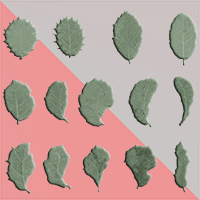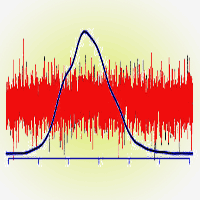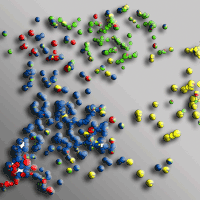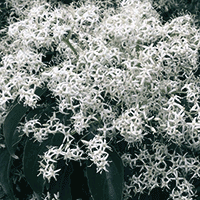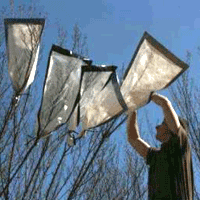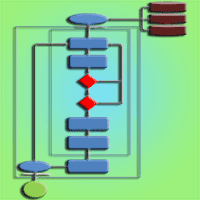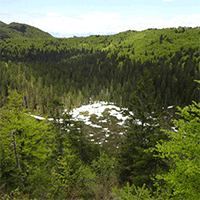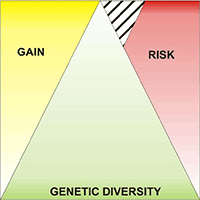The genus Quercus is known for the occurrence of frequent hybridization events between species. Although this phenomenon is not common among holm oak (Q. ilex) and cork oak (Q. suber), these species can hybridize when they coexist in mixed stands. The result of hybridization is a viable hybrid progeny with very heterogeneous leaf morphology. Literature concerning the leaf morphology of suber-ilex hybrid seedlings is scarce, and non-existent from a quantitative point of view. In the case of the leaf morphology of hybrids and their progeny, it has been observed a high frequency of leaves with fluctuating asymmetry or developmental abnormalities, which can have a marked effect on fitness. In this work, we have characterized seedlings’ leaf morphology corresponding to two- and four-year-old half-sib progenies of holm oak, cork oak and their hybrids. For this purpose, three to ten leaves of each individual were collected, and two methodologies were used for analysis. Firstly, we used a classic morphological analysis of twelve variables that were reduced using multivariate techniques. On the other hand, shape of the leaves was thoroughly analyzed by geometric morphometric analysis methods. The extent of fluctuating asymmetry and the presence of developmental abnormalities of seedlings were analyzed calculating an asymmetry index. The results indicate that thickness is the most discriminating trait between species, and that the hybrid progenies do not show a third different phenotype compared to the parental species. However, half-siblings tend to show similar leaf morphology between them, depending on the genetic adscription of the parents. While fluctuating asymmetry was found in half-sib progenies of the parental species and the hybrids, a significant proportion of hybrid half-sibs showed strong leaf asymmetry, probably due to modifications of the epigenetic systems that control leaf development at the shoot apical meristems and leaf primordia.
Keywords
, , ,
Citation
López De Heredia U, Duro-García MJ, Soto Á (2018). Leaf morphology of progenies in Q. suber, Q. ilex, and their hybrids using multivariate and geometric morphometric analysis. iForest 11: 90-98. - doi: 10.3832/ifor2577-010
Academic Editor
Piermaria Corona
Paper history
Received: Jul 31, 2017
Accepted: Oct 28, 2017
First online: Jan 31, 2018
Publication Date: Feb 28, 2018
Publication Time: 3.17 months
© SISEF - The Italian Society of Silviculture and Forest Ecology 2018
Open Access
This article is distributed under the terms of the Creative Commons Attribution-Non Commercial 4.0 International (https://creativecommons.org/licenses/by-nc/4.0/), which permits unrestricted use, distribution, and reproduction in any medium, provided you give appropriate credit to the original author(s) and the source, provide a link to the Creative Commons license, and indicate if changes were made.

Breakdown by View Type
(Waiting for server response...)
Article Usage
Total Article Views: 50591
(from publication date up to now)
Breakdown by View Type
HTML Page Views: 41500
Abstract Page Views: 4026
PDF Downloads: 4016
Citation/Reference Downloads: 14
XML Downloads: 1035
Web Metrics
Days since publication: 2890
Overall contacts: 50591
Avg. contacts per week: 122.54
Article Citations
Article citations are based on data periodically collected from the Clarivate Web of Science web site
(last update: Mar 2025)
Total number of cites (since 2018): 11
Average cites per year: 1.38
Publication Metrics
by Dimensions ©
Articles citing this article
List of the papers citing this article based on CrossRef Cited-by.
(1)
Abramoff MD, Magalhaes PJ, Ram SJ (2004)Image processing with ImageJ. Biophotonics International 11 (7): 36-42.
Gscholar
(2)
Adams DC, Otárola-Castillo E (2013)geomorph: an R package for the collection and analysis of geometric morphometric shape data. Methods in Ecology and Evolution 4: 393-399.
CrossRef |
Gscholar
(3)
Albarrán-Lara AL, Mendoza-Cuenca L, Valencia-Avalos S, González-Rodríguez A, Oyama K (2010)Leaf fluctuating asymmetry increases with hybridization and introgression between
Quercus magnoliifolia and
Quercus resinosa (Fagaceae) through an altitudinal gradient in Mexico. International Journal of Plant Sciences 171 (3): 310-322.
CrossRef |
Gscholar
(4)
Amaral Franco J (1990)Quercus L. In: “Flora Ibérica” (Castroviejo S, Lainz M, López González G eds). Real Jardín Botánico, CSIC, Madrid, Spain, vol. 12, pp. 15-36. [in Spanish]
Gscholar
(5)
Barkoulas M, Galinha C, Grigg SP, Tsiantis M (2007)From genes to shape: regulatory interactions in leaf development. Current Opinion in Plant Biology 10: 660-666.
CrossRef |
Gscholar
(6)
Blue MP, Jensen RJ (1988)Positional and seasonal variation in oak (
Quercus, Fagaceae) leaf morphology. American Journal of Botany 75: 939-947.
CrossRef |
Gscholar
(7)
Bonhomme V, Picq S, Gaucherel C, Claude J (2014)Momocs: outline analysis using R. Journal of Statistical Software 56 (13): 1-24.
CrossRef |
Gscholar
(8)
Bruschi P, Vendramin GG, Bussotti F, Grossoni P (2003)Morphological and molecular diversity among Italian populations of
Quercus petraea (Fagaceae). Annals of Botany 91 (6): 707-716.
CrossRef |
Gscholar
(9)
Burgarella C, Lorenzo Z, Jabbour-Zahab R, Lumaret R, Guichoux E, Petit RJ, Soto A, Gil L (2009)Detection of hybrids in nature: application to oaks (
Quercus suber and
Q. ilex). Heredity 102: 442-452.
CrossRef |
Gscholar
(10)
Cardillo E, Bernal CJ (2006)Morphological response and growth of cork oak (
Quercus suber L.) seedlings at different shade levels. Forest Ecology and Management 222 (1-3): 296-301.
CrossRef |
Gscholar
(11)
Castro-Díez P, Puyravaud JP, Cornelissen JHC (2000)Leaf structure and anatomy as related to leaf mass per area variation in seedlings of a wide range of woody plant species and types. Oecologia 124: 476-486.
CrossRef |
Gscholar
(12)
Cornelissen JHC (1999)A triangular relationship between leaf size and seed size among woody species: allometry, ontogeny, ecology and taxonomy. Oecologia 118: 248-255.
CrossRef |
Gscholar
(13)
Durkovič J, Kardošová M, Canová I, Lagana R, Priwitzer T, Chorvát D, Cicák A, Pichler V (2012)Leaf traits in parental and hybrid species of
Sorbus (Rosaceae). American Journal of Botany 99: 1489-1500.
CrossRef |
Gscholar
(14)
Gailing O (2008)QTL analysis of leaf morphological characters in a
Quercus robur full-sib family (
Q. robur x
Q. robur ssp.
slavonica). Plant Biology 10 (5): 624-34.
CrossRef |
Gscholar
(15)
Graham JH, Raz S, Hel-Or H, Nevo E (2010)Fluctuating asymmetry: methods, theory, and applications. Symmetry 2: 466-540.
CrossRef |
Gscholar
(16)
Gugerli F, Walser JC, Dounavi K, Holderegger R, Finkeldey R (2007)Coincidence of small-scale spatial discontinuities in leaf morphology and nuclear microsatellite variation of
Quercus petraea and
Q. robur in a mixed forest. Annals of Botany 99 (4): 713-722.
CrossRef |
Gscholar
(17)
Harper JL (1977)Population biology of plants. Academic Press, London, UK, pp. 906.
Gscholar
(18)
Himrane H, Camarero JJ, Gil-Pelegrín E (2004)Morphological and ecophy-siological variation of the hybrid oak
Quercus subpyrenaica (Q. faginea x
Q. pubescens). Trees 18: 566-575.
CrossRef |
Gscholar
(19)
Hódar JA (2002)Leaf fluctuating asymmetry of Holm oak in response to drought under contrasting climatic conditions. Journal of Arid Environments 52: 233-243.
CrossRef |
Gscholar
(20)
Kleinschmit JRG, Bacilieri R, Kremer A, Roloff A (1995)Comparison of morphological and genetic traits of pedunculate oak (
Q. robur L) and sessile oak (
Q. petraea (Matt) Liebl). Silvae Genetica 44 (5-6): 256-269.
Gscholar
(21)
Kozlov MV (2003)Are fast growing birch leaves more asymmetrical? Oikos 101: 654-658.
CrossRef |
Gscholar
(22)
Kremer A, Dupouey JL, Deans JD, Cottrell J, Csaikl U, Finkeldey R, Espinel S, Jensen J, Kleinschmit J, Van Dam B, Ducousso A, Forrest I, Lopez De Heredia U, Lowe AJ, Tutkova M, Munro RC, Steinhoff S, Badeau V (2002)Leaf morphological differentiation between
Quercus robur and
Quercus petraea is stable across western European mixed oak stands. Annals of Forest Sciences 59 (7): 777-787.
CrossRef |
Gscholar
(23)
Laguna M (1881)Un mesto italiano y varios mestos espanoles [An Italian “mesto” and several Spanish “mestos”]. Revista Montes 114: 477-486. [in Spanish]
Gscholar
(24)
Lodha M, Marco CF, Timmermans MCP (2013)The ASYMMETRIC LEAVES complex maintains repression of KNOX homeobox genes via direct recruitment of Polycomb-repressive complex2. Genes and Development 27: 596-601.
CrossRef |
Gscholar
(25)
López De Heredia U, Sánchez-Pastor H, Soto A (2017)Molecular evidence of bidirectional introgression between
Quercus suber and
Quercus ilex. iForest [submitted].
Gscholar
(26)
Matsumura Y, Ohbayashi I, Takahashi H, Kojima S, Ishibashi N, Keta S, Nakagawa A, Hayashi R, Saéz-Vázquez J, Echeverria M, Sugiyama M, Nakamura K, Machida C, Machida Y (2016)A genetic link between epigenetic repressor AS1-AS2 and a putative small subunit processome in leaf polarity establishment of
Arabidopsis. Biology Open 5 (7): 942-954.
CrossRef |
Gscholar
(27)
McDonald PG, Fonseca CR, Overton JM, Westoby M (2003)Leaf-size divergence along rainfall and soil-nutrient gradients: is the method of size reduction common among clades? Functional Ecology 17: 50-57.
CrossRef |
Gscholar
(28)
Mediavilla S, Escudero A (2003)Leaf life span differs from retention time of biomass and nutrients in the crowns of evergreen species. Functional Ecology 17: 541-548.
CrossRef |
Gscholar
(29)
Mediavilla S, González-Zurdo P, García-Ciudad A, Escudero A (2011)Morphological and chemical leaf composition of Mediterranean evergreen tree species according to leaf age. Trees 25 (4) 669-677.
CrossRef |
Gscholar
(30)
Mediavilla S, Gallardo-López V, González-Zurdo P, Escudero A (2012)Patterns of leaf morphology and leaf N content in relation to winter temperatures in three evergreen tree species. International Journal of Biometeorology 56: 915-926.
CrossRef |
Gscholar
(31)
Mendiburu F, Simon R (2015)Agricolae - Ten years of an open source statistical tool for experiments in breeding, agriculture and biology. PeerJ PrePrints 3: e1748v1.
Online |
Gscholar
(32)
Milligan J, Krebs R, Mal T (2008)Separating developmental and environmental effects on fluctuating asymmetry in
Lythrum salicaria and
Penthorum sedoides. International Journal of Plant Sciences 169 (5): 625-630.
CrossRef |
Gscholar
(33)
Nicotra AB, Leigh A, Boyce CK, Jones CS, Niklas KJ, Royer DL, Tsukaya H (2011)The evolution and functional significance of leaf shape in the angiosperms. Functional Plant Biology 38: 535-552.
CrossRef |
Gscholar
(34)
Niinemets U (2015)Is there a species spectrum within the world-wide leaf economics spectrum? Major variations in leaf functional traits in the Mediterranean sclerophyll
Quercus ilex. New Phytologist 205: 79-96.
CrossRef |
Gscholar
(35)
Parsons PA (1990)Fluctuating asymmetry: an epigenetic measure of stress. Biological Reviews of the Cambridge Philosophical Society 65: 131-145.
CrossRef |
Gscholar
(36)
Peguero-Pina JJ, Sancho-Knapik D, Barrón E, Camarero JJ, Vilagrosa A, Gil-Pelegrín E (2014)Morphological and physiological divergences within
Quercus ilex support the existence of different ecotypes depending on climatic dryness. Annals of Botany 114 (2): 301-313.
CrossRef |
Gscholar
(37)
Pinheiro J, Bates D, DebRoy S, Sarkar D (2017)nlme: linear and nonlinear mixed effects models. R package version 3:1-131.
Online |
Gscholar
(38)
Poorter L (2007)Are species adapted to their regeneration niche, adult niche, or both? American Naturalist 169: 433-442.
CrossRef |
Gscholar
(39)
Poorter H, Niinemets U, Poorter L, Wright I, Villar R (2009)Causes and consequences of variation in leaf mass per area (LMA): a meta-analysis. New Phytologist 182: 565-588.
CrossRef |
Gscholar
(40)
Pritchard JK, Wen X, Falush D (2010)Documentation for structure software, version 2. 3. Web site.
Online |
Gscholar
(41)
Puerta-Piñero C, Gómez JM, Hódar JA (2008)Shade and herbivory induce fluctuating asymmetry in a Mediterranean oak. International Journal of Plant Sciences 169 (5): 631-635.
CrossRef |
Gscholar
(42)
Quero JL, Villar R, Marañón T, Zamora R (2006)Interactions of drought and shade effects on seedlings of four
Quercus species: physiological and structural leaf responses. New Phytologist 170: 819-834.
CrossRef |
Gscholar
(43)
R Core Team (2016)R: a language and environment for statistical computing. R Foundation for Statistical Computing, Vienna, Austria.
Online |
Gscholar
(44)
Rieseberg LH, Ellstrand NC (1993)What can molecular and morphological markers tell us about plant hybridization? Critical Reviews in Plant Sciences 12: 213-241.
CrossRef |
Gscholar
(45)
Rohlf FJ, Slice DE (1990)Extensions of the Procrustes Method for the optimal superimposition of landmarks. Systematic Zoology 39: 40-59.
CrossRef |
Gscholar
(46)
Sack L, Melcher PJ, Liu WH, Middleton E, Pardee T (2006)How strong is intracanopy leaf plasticity in temperate deciduous trees? American Journal of Botany 93 (6): 829-839.
CrossRef |
Gscholar
(47)
Scotti-Saintagne C, Mariette S, Porth I, Goicoechea PG, Barreneche T, Bodénès C, Kremer A (2004)Genome scanning for interspecific differentiation between two closely related oak species (
Quercus robur L. and
Q. petraea (Matt.) Liebl.). Genetics 168 (3): 1615-1626.
CrossRef |
Gscholar
(48)
Takanashi H, Marubashi W (2017)Tumorigenesis inheritance from the putative progenitor species of Nicotiana rustica. Plant Biotechnology 34 (2): 79-87.
CrossRef |
Gscholar
(49)
Tsukaya H (2005)Leaf shape: genetic controls and environmental factors. International Journal of Developmental Biology 49 (5-6): 547-55.
CrossRef |
Gscholar
(50)
Viscosi V (2015)Geometric morphometrics and leaf phenotypic plasticity: assessing fluctuating asymmetry and allometry in European white oaks (
Quercus). Botanical Journal of the Linnean Society 179: 335-348.
CrossRef |
Gscholar
(51)
Weight C, Parnham D, Waites R (2008)Technical Advance - LeafAnalyser: a computational method for rapid and large-scale analyses of leaf shape variation. The Plant Journal 53 (3): 578-586.
CrossRef |
Gscholar
(52)
Wilsey BJ, Haukioja E, Koricheva J, Sulkinoja M (1998)Leaf fluctuating asymmetry increases with hybridization and elevation in tree-line birches. Ecology 79: 2092-2099.
CrossRef |
Gscholar
(53)
Valladares F, Niinemets U (2008)Shade tolerance, a key plant feature of complex nature and consequences. Annual Review of Ecology, Evolution and Systematics 39: 237-257.
CrossRef |
Gscholar
(54)
Vaz M, Maroco J, Ribeiro N, Gazarini LC, Pereira JS, Chaves MM (2011)Leaf level responses to light in two co-occurring
Quercus (Quercus ilex and
Quercus suber): leaf structure, chemical composition and photosynthesis. Agroforestry Systems 82: 173-181.
CrossRef |
Gscholar
